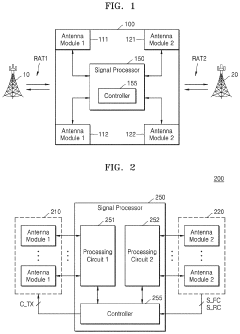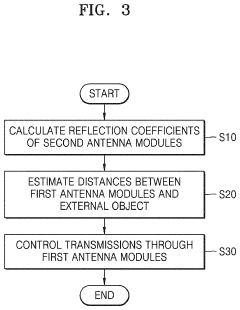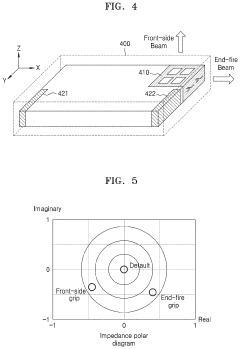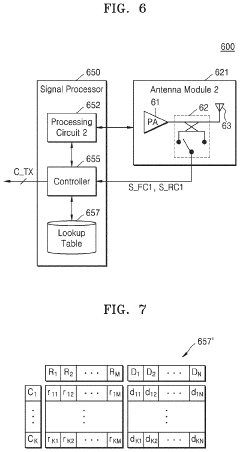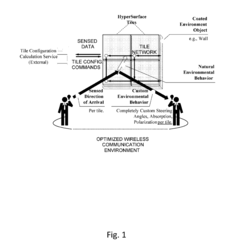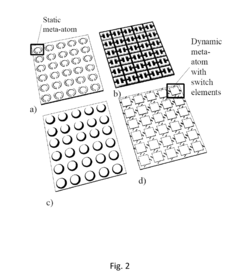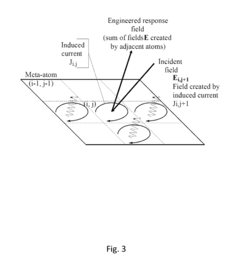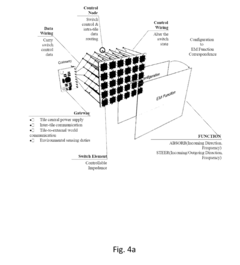Harnessing Electromagnetic Waves for Wireless Communication
JUL 11, 20258 MIN READ
Generate Your Research Report Instantly with AI Agent
Patsnap Eureka helps you evaluate technical feasibility & market potential.
EM Wave Tech Evolution
The evolution of electromagnetic wave technology for wireless communication has been a remarkable journey spanning over a century. It began with Heinrich Hertz's experimental confirmation of James Clerk Maxwell's electromagnetic theory in the late 19th century, laying the foundation for wireless communication.
The early 20th century saw significant advancements with Guglielmo Marconi's pioneering work in radio telegraphy. This led to the development of amplitude modulation (AM) and frequency modulation (FM) techniques, revolutionizing long-distance communication and broadcasting. The advent of radar technology during World War II further accelerated the understanding and application of electromagnetic waves.
The mid-20th century marked a pivotal era with the invention of the transistor and the subsequent development of integrated circuits. These breakthroughs enabled the miniaturization of radio equipment, paving the way for portable communication devices. The launch of communication satellites in the 1960s expanded the reach of wireless communication to a global scale.
The late 20th century witnessed the birth of cellular networks, starting with the first-generation (1G) analog systems in the 1980s. This was quickly followed by the digital 2G networks in the 1990s, introducing text messaging and basic data services. The rapid progression continued with 3G networks at the turn of the millennium, offering improved data speeds and enabling mobile internet access.
The 21st century has seen exponential growth in wireless communication technology. The introduction of 4G networks in the 2010s brought high-speed mobile broadband, supporting video streaming and advanced mobile applications. This era also saw the widespread adoption of Wi-Fi technology, revolutionizing local area networks and home connectivity.
Most recently, the deployment of 5G networks marks a significant leap in wireless communication capabilities. 5G technology promises ultra-low latency, massive device connectivity, and unprecedented data speeds. This advancement is expected to enable new applications in areas such as autonomous vehicles, smart cities, and the Internet of Things (IoT).
Looking ahead, research is already underway for 6G technology, which aims to integrate terrestrial, satellite, and airborne networks. Future developments may include terahertz communication, quantum communication, and advanced AI-driven network optimization, pushing the boundaries of what's possible in harnessing electromagnetic waves for wireless communication.
The early 20th century saw significant advancements with Guglielmo Marconi's pioneering work in radio telegraphy. This led to the development of amplitude modulation (AM) and frequency modulation (FM) techniques, revolutionizing long-distance communication and broadcasting. The advent of radar technology during World War II further accelerated the understanding and application of electromagnetic waves.
The mid-20th century marked a pivotal era with the invention of the transistor and the subsequent development of integrated circuits. These breakthroughs enabled the miniaturization of radio equipment, paving the way for portable communication devices. The launch of communication satellites in the 1960s expanded the reach of wireless communication to a global scale.
The late 20th century witnessed the birth of cellular networks, starting with the first-generation (1G) analog systems in the 1980s. This was quickly followed by the digital 2G networks in the 1990s, introducing text messaging and basic data services. The rapid progression continued with 3G networks at the turn of the millennium, offering improved data speeds and enabling mobile internet access.
The 21st century has seen exponential growth in wireless communication technology. The introduction of 4G networks in the 2010s brought high-speed mobile broadband, supporting video streaming and advanced mobile applications. This era also saw the widespread adoption of Wi-Fi technology, revolutionizing local area networks and home connectivity.
Most recently, the deployment of 5G networks marks a significant leap in wireless communication capabilities. 5G technology promises ultra-low latency, massive device connectivity, and unprecedented data speeds. This advancement is expected to enable new applications in areas such as autonomous vehicles, smart cities, and the Internet of Things (IoT).
Looking ahead, research is already underway for 6G technology, which aims to integrate terrestrial, satellite, and airborne networks. Future developments may include terahertz communication, quantum communication, and advanced AI-driven network optimization, pushing the boundaries of what's possible in harnessing electromagnetic waves for wireless communication.
Wireless Comm Demand
The demand for wireless communication technologies has experienced exponential growth in recent years, driven by the increasing need for connectivity in both personal and professional spheres. This surge in demand is primarily fueled by the proliferation of smart devices, the Internet of Things (IoT), and the ongoing digital transformation across various industries.
In the consumer market, the adoption of smartphones, tablets, and wearable devices has skyrocketed, creating a substantial need for reliable and high-speed wireless connectivity. Users expect seamless access to data-intensive applications, streaming services, and cloud-based platforms, pushing the boundaries of existing wireless infrastructure.
The enterprise sector has also witnessed a significant shift towards mobile and remote work environments, accelerated by recent global events. This transition has amplified the demand for robust wireless solutions that can support secure and efficient communication across distributed teams. Additionally, the implementation of smart office technologies and IoT devices in corporate settings has further intensified the need for advanced wireless networks.
Emerging technologies such as augmented reality (AR), virtual reality (VR), and autonomous vehicles are poised to revolutionize various industries but require ultra-reliable and low-latency wireless communication to function effectively. These applications demand unprecedented levels of network performance, driving innovation in wireless technologies.
The industrial sector is embracing Industry 4.0 concepts, which heavily rely on wireless communication for connecting machinery, sensors, and control systems. This industrial IoT ecosystem requires specialized wireless solutions that can operate reliably in challenging environments while supporting massive device connectivity.
In the healthcare industry, the adoption of telemedicine and remote patient monitoring has surged, creating a critical need for secure and high-bandwidth wireless communication. These applications have the potential to transform healthcare delivery but depend on robust wireless infrastructure to ensure seamless connectivity between patients and healthcare providers.
The smart city initiatives being implemented worldwide are another significant driver of wireless communication demand. These projects aim to enhance urban living through connected infrastructure, intelligent transportation systems, and efficient resource management, all of which rely heavily on advanced wireless networks.
As we move towards a more connected world, the demand for wireless communication is expected to continue its upward trajectory. This growth presents both challenges and opportunities for technology developers, network operators, and service providers to innovate and deliver solutions that can meet the evolving needs of diverse user groups and industries.
In the consumer market, the adoption of smartphones, tablets, and wearable devices has skyrocketed, creating a substantial need for reliable and high-speed wireless connectivity. Users expect seamless access to data-intensive applications, streaming services, and cloud-based platforms, pushing the boundaries of existing wireless infrastructure.
The enterprise sector has also witnessed a significant shift towards mobile and remote work environments, accelerated by recent global events. This transition has amplified the demand for robust wireless solutions that can support secure and efficient communication across distributed teams. Additionally, the implementation of smart office technologies and IoT devices in corporate settings has further intensified the need for advanced wireless networks.
Emerging technologies such as augmented reality (AR), virtual reality (VR), and autonomous vehicles are poised to revolutionize various industries but require ultra-reliable and low-latency wireless communication to function effectively. These applications demand unprecedented levels of network performance, driving innovation in wireless technologies.
The industrial sector is embracing Industry 4.0 concepts, which heavily rely on wireless communication for connecting machinery, sensors, and control systems. This industrial IoT ecosystem requires specialized wireless solutions that can operate reliably in challenging environments while supporting massive device connectivity.
In the healthcare industry, the adoption of telemedicine and remote patient monitoring has surged, creating a critical need for secure and high-bandwidth wireless communication. These applications have the potential to transform healthcare delivery but depend on robust wireless infrastructure to ensure seamless connectivity between patients and healthcare providers.
The smart city initiatives being implemented worldwide are another significant driver of wireless communication demand. These projects aim to enhance urban living through connected infrastructure, intelligent transportation systems, and efficient resource management, all of which rely heavily on advanced wireless networks.
As we move towards a more connected world, the demand for wireless communication is expected to continue its upward trajectory. This growth presents both challenges and opportunities for technology developers, network operators, and service providers to innovate and deliver solutions that can meet the evolving needs of diverse user groups and industries.
EM Wave Challenges
Electromagnetic waves form the backbone of wireless communication, yet their utilization presents significant challenges. One of the primary obstacles is signal attenuation, which occurs as electromagnetic waves travel through various mediums. This phenomenon leads to a reduction in signal strength and quality, particularly over long distances or through dense materials.
Another major challenge is interference, both from natural sources and other wireless devices. As the electromagnetic spectrum becomes increasingly crowded, managing and mitigating interference becomes crucial for maintaining reliable communication. This issue is particularly pronounced in urban environments where numerous wireless networks coexist.
Multipath propagation poses another significant hurdle. When electromagnetic waves encounter obstacles, they can reflect, refract, or diffract, resulting in multiple copies of the same signal arriving at the receiver at different times. This can cause signal distortion and intersymbol interference, complicating the decoding process at the receiver end.
The limited available spectrum is an ongoing concern in wireless communication. As demand for wireless services grows, efficiently utilizing the finite electromagnetic spectrum becomes increasingly challenging. This necessitates the development of advanced modulation and multiplexing techniques to maximize spectral efficiency.
Power consumption in wireless devices presents another challenge, especially for mobile and IoT applications. Transmitting electromagnetic waves requires energy, and balancing power usage with communication range and data rate is a constant struggle for device manufacturers and network operators.
Security and privacy concerns also arise when harnessing electromagnetic waves for communication. As wireless signals can be intercepted, ensuring the confidentiality and integrity of transmitted data becomes paramount. This challenge extends to preventing unauthorized access to wireless networks and protecting against various forms of electromagnetic attacks.
The dynamic nature of wireless channels adds another layer of complexity. Factors such as weather conditions, physical obstructions, and mobility can cause rapid fluctuations in channel characteristics, requiring adaptive techniques to maintain reliable communication.
Lastly, regulatory compliance presents a challenge in the utilization of electromagnetic waves. Different countries have varying regulations regarding frequency allocation, transmission power limits, and electromagnetic radiation exposure. Navigating these regulatory landscapes while developing globally compatible wireless technologies adds complexity to the field.
Another major challenge is interference, both from natural sources and other wireless devices. As the electromagnetic spectrum becomes increasingly crowded, managing and mitigating interference becomes crucial for maintaining reliable communication. This issue is particularly pronounced in urban environments where numerous wireless networks coexist.
Multipath propagation poses another significant hurdle. When electromagnetic waves encounter obstacles, they can reflect, refract, or diffract, resulting in multiple copies of the same signal arriving at the receiver at different times. This can cause signal distortion and intersymbol interference, complicating the decoding process at the receiver end.
The limited available spectrum is an ongoing concern in wireless communication. As demand for wireless services grows, efficiently utilizing the finite electromagnetic spectrum becomes increasingly challenging. This necessitates the development of advanced modulation and multiplexing techniques to maximize spectral efficiency.
Power consumption in wireless devices presents another challenge, especially for mobile and IoT applications. Transmitting electromagnetic waves requires energy, and balancing power usage with communication range and data rate is a constant struggle for device manufacturers and network operators.
Security and privacy concerns also arise when harnessing electromagnetic waves for communication. As wireless signals can be intercepted, ensuring the confidentiality and integrity of transmitted data becomes paramount. This challenge extends to preventing unauthorized access to wireless networks and protecting against various forms of electromagnetic attacks.
The dynamic nature of wireless channels adds another layer of complexity. Factors such as weather conditions, physical obstructions, and mobility can cause rapid fluctuations in channel characteristics, requiring adaptive techniques to maintain reliable communication.
Lastly, regulatory compliance presents a challenge in the utilization of electromagnetic waves. Different countries have varying regulations regarding frequency allocation, transmission power limits, and electromagnetic radiation exposure. Navigating these regulatory landscapes while developing globally compatible wireless technologies adds complexity to the field.
Current EM Solutions
01 Antenna design for electromagnetic wave communication
Various antenna designs are utilized to improve electromagnetic wave communication. These include specialized configurations to enhance signal transmission and reception, optimize bandwidth, and reduce interference. Advanced antenna designs can significantly improve the efficiency and reliability of wireless communication systems.- Antenna design for electromagnetic wave communication: Innovative antenna designs are crucial for efficient electromagnetic wave communication. These designs focus on improving signal strength, directionality, and bandwidth. Advanced antenna configurations can enhance the overall performance of communication systems, allowing for better data transmission and reception across various frequencies.
- Electromagnetic shielding techniques: Electromagnetic shielding is essential in preventing interference and ensuring the integrity of communication signals. Various materials and structures are employed to create effective shields that block unwanted electromagnetic waves. These techniques are particularly important in sensitive electronic devices and high-frequency communication systems.
- Wireless power transmission using electromagnetic waves: Electromagnetic waves can be utilized for wireless power transmission, enabling the charging of devices without physical connections. This technology involves the use of specialized transmitters and receivers to convert electromagnetic energy into usable electrical power. It has applications in various fields, including consumer electronics and industrial systems.
- Modulation techniques for electromagnetic wave communication: Advanced modulation techniques are employed to improve the efficiency and reliability of electromagnetic wave communication. These methods involve manipulating signal characteristics such as amplitude, frequency, or phase to encode information. Innovative modulation schemes can increase data transmission rates and enhance signal quality in various communication systems.
- Electromagnetic wave propagation in challenging environments: Developing solutions for electromagnetic wave propagation in challenging environments is crucial for maintaining reliable communication. This includes addressing issues such as signal attenuation, multipath fading, and interference in urban areas, underwater, or through dense materials. Novel approaches are being explored to overcome these obstacles and ensure consistent communication in diverse settings.
02 Electromagnetic shielding techniques
Electromagnetic shielding is crucial in preventing interference and improving signal quality in communication systems. This involves the use of materials and structures that can block or absorb electromagnetic waves, protecting sensitive components and reducing signal degradation. Effective shielding contributes to the overall performance of communication devices.Expand Specific Solutions03 Modulation and signal processing methods
Advanced modulation techniques and signal processing methods are employed to enhance the efficiency of electromagnetic wave communication. These include various algorithms for encoding and decoding signals, error correction, and noise reduction. Such methods improve data transmission rates, reliability, and spectral efficiency in wireless communication systems.Expand Specific Solutions04 Frequency band utilization and management
Effective utilization and management of frequency bands are essential for optimizing electromagnetic wave communication. This involves techniques for frequency allocation, spectrum sharing, and dynamic spectrum access. Proper frequency management helps in accommodating multiple users and services while minimizing interference and maximizing overall system capacity.Expand Specific Solutions05 Energy-efficient communication techniques
Energy efficiency is a critical aspect of modern electromagnetic wave communication systems. Various techniques are employed to reduce power consumption while maintaining communication quality. These include adaptive power control, sleep modes for devices, and energy-efficient protocols. Such approaches extend battery life in mobile devices and reduce the environmental impact of communication networks.Expand Specific Solutions
Key Telecom Players
The wireless communication industry, driven by electromagnetic wave technology, is in a mature yet continuously evolving phase. The market size is substantial, with global revenues exceeding $1 trillion annually. Technological maturity varies across different aspects, with 5G deployment ongoing and 6G research underway. Key players like Nokia, Samsung, and Huawei lead in infrastructure, while Sony, Canon, and Apple dominate consumer devices. Companies such as Qualcomm and Intel are at the forefront of chip development. The competitive landscape is intense, with established giants facing challenges from innovative startups and cross-industry entrants like automotive companies exploring connected vehicle technologies. Research institutions and universities play crucial roles in advancing fundamental technologies, ensuring a dynamic and forward-looking industry ecosystem.
Nokia Technologies Oy
Technical Solution: Nokia has been at the forefront of wireless communication technology for decades. Their approach to harnessing electromagnetic waves focuses on advanced antenna designs and signal processing techniques. Nokia's 5G AirScale Radio Access solutions utilize massive MIMO technology, which employs multiple antennas to improve spectral efficiency and network capacity[1]. They have also developed ReefShark chipsets that enhance the performance of radio and baseband units in 5G networks, significantly reducing size and power consumption while increasing capacity[2]. Nokia's end-to-end 5G portfolio includes advanced radio access networks (RAN), core networks, and transport solutions that leverage electromagnetic waves for high-speed, low-latency communication[3].
Strengths: Extensive experience in telecommunications, strong R&D capabilities, and a comprehensive 5G portfolio. Weaknesses: Facing intense competition from other major players in the 5G market.
Samsung Electronics Co., Ltd.
Technical Solution: Samsung's approach to harnessing electromagnetic waves for wireless communication is multifaceted. They have developed advanced 5G solutions, including their 5G New Radio (NR) technology. Samsung's 5G NR solutions utilize mmWave spectrum for ultra-high-speed data transmission, achieving speeds up to 20 Gbps[4]. Their Massive MIMO technology employs hundreds of antenna elements to focus energy into desired directions, improving coverage and capacity[5]. Samsung has also pioneered the development of 6G technology, exploring terahertz (THz) frequency bands for even higher data rates and lower latency in future wireless systems[6]. Their research includes advanced beamforming techniques and AI-powered network optimization to enhance the efficiency of electromagnetic wave utilization.
Strengths: Strong presence in both network infrastructure and consumer devices, enabling end-to-end solutions. Weaknesses: Relatively newer entrant in network equipment compared to some competitors.
EM Wave Innovations
Apparatuses and methods for controlling exposure to wireless communication
PatentActiveUS20210385763A1
Innovation
- A signal processing apparatus and method that utilize multiple antenna modules operating in different frequency bands to control transmission power based on reflection coefficients and estimated distances from external objects, allowing for reduced exposure to electromagnetic waves without degrading communication quality.
New wireless communication paradigm: realizing programmable wireless environments through software-controlled metasurfaces
PatentInactiveUS20190044246A1
Innovation
- The introduction of HyperSurfaces, a class of software-controlled metasurfaces that can interact with impinging electromagnetic waves in a programmable manner, allowing for deterministic and optimizable wireless behavior by coating objects with networked control elements that adjust their electromagnetic properties based on environmental data.
Spectrum Regulations
Spectrum regulations play a crucial role in the effective harnessing of electromagnetic waves for wireless communication. These regulations are established and enforced by national and international bodies to manage the use of the radio frequency spectrum, ensuring efficient and interference-free operation of various wireless services.
The International Telecommunication Union (ITU) serves as the primary global authority for spectrum allocation. Through its Radio Regulations, the ITU defines the allocation of frequency bands to different radio services on a worldwide basis. These regulations are periodically updated at World Radiocommunication Conferences (WRCs) to adapt to technological advancements and changing communication needs.
At the national level, regulatory bodies such as the Federal Communications Commission (FCC) in the United States and Ofcom in the United Kingdom are responsible for implementing and enforcing spectrum regulations within their respective jurisdictions. These agencies manage spectrum licensing, set technical standards, and monitor compliance to maintain order in the airwaves.
Spectrum regulations typically address several key aspects of wireless communication. Frequency allocation determines which services can operate in specific frequency bands, preventing interference between different applications. Power limits are imposed to control the strength of transmitted signals, reducing the potential for interference with neighboring systems and minimizing health concerns related to electromagnetic radiation exposure.
Modulation techniques and bandwidth restrictions are also regulated to ensure efficient use of the limited spectrum resources. These technical parameters influence the data capacity and range of wireless systems, balancing the needs of various services and users.
The advent of new technologies, such as 5G and beyond, has led to significant changes in spectrum regulations. Regulators are exploring innovative approaches like dynamic spectrum access and shared spectrum use to accommodate the growing demand for wireless connectivity. These approaches aim to maximize spectrum utilization while maintaining the quality and reliability of existing services.
Spectrum auctions have become a common method for allocating valuable frequency bands to commercial operators. These auctions generate substantial revenue for governments while promoting competition and innovation in the telecommunications sector. However, they also raise concerns about spectrum hoarding and potential barriers to market entry for smaller players.
As wireless technologies continue to evolve, spectrum regulations must adapt to support emerging applications such as Internet of Things (IoT) devices, autonomous vehicles, and satellite-based broadband services. This ongoing process requires careful balancing of competing interests and a forward-looking approach to spectrum management.
The International Telecommunication Union (ITU) serves as the primary global authority for spectrum allocation. Through its Radio Regulations, the ITU defines the allocation of frequency bands to different radio services on a worldwide basis. These regulations are periodically updated at World Radiocommunication Conferences (WRCs) to adapt to technological advancements and changing communication needs.
At the national level, regulatory bodies such as the Federal Communications Commission (FCC) in the United States and Ofcom in the United Kingdom are responsible for implementing and enforcing spectrum regulations within their respective jurisdictions. These agencies manage spectrum licensing, set technical standards, and monitor compliance to maintain order in the airwaves.
Spectrum regulations typically address several key aspects of wireless communication. Frequency allocation determines which services can operate in specific frequency bands, preventing interference between different applications. Power limits are imposed to control the strength of transmitted signals, reducing the potential for interference with neighboring systems and minimizing health concerns related to electromagnetic radiation exposure.
Modulation techniques and bandwidth restrictions are also regulated to ensure efficient use of the limited spectrum resources. These technical parameters influence the data capacity and range of wireless systems, balancing the needs of various services and users.
The advent of new technologies, such as 5G and beyond, has led to significant changes in spectrum regulations. Regulators are exploring innovative approaches like dynamic spectrum access and shared spectrum use to accommodate the growing demand for wireless connectivity. These approaches aim to maximize spectrum utilization while maintaining the quality and reliability of existing services.
Spectrum auctions have become a common method for allocating valuable frequency bands to commercial operators. These auctions generate substantial revenue for governments while promoting competition and innovation in the telecommunications sector. However, they also raise concerns about spectrum hoarding and potential barriers to market entry for smaller players.
As wireless technologies continue to evolve, spectrum regulations must adapt to support emerging applications such as Internet of Things (IoT) devices, autonomous vehicles, and satellite-based broadband services. This ongoing process requires careful balancing of competing interests and a forward-looking approach to spectrum management.
EM Health Impacts
The potential health impacts of electromagnetic (EM) waves used in wireless communication have been a subject of ongoing research and debate. While the technology has revolutionized modern communication, concerns about its long-term effects on human health persist. Studies have shown that high-frequency electromagnetic fields (EMFs) can cause tissue heating, which is the primary mechanism of interaction between radiofrequency (RF) energy and biological systems.
The World Health Organization (WHO) has classified RF electromagnetic fields as possibly carcinogenic to humans, based on an increased risk for glioma, a type of brain cancer, associated with wireless phone use. However, the evidence is not conclusive, and more research is needed to fully understand the potential long-term health effects of prolonged exposure to EM waves.
Some individuals report experiencing electromagnetic hypersensitivity (EHS), characterized by symptoms such as headaches, fatigue, and skin irritation when exposed to EMFs. While EHS is not a recognized medical diagnosis, it highlights the need for further investigation into the biological effects of EM radiation.
The International Commission on Non-Ionizing Radiation Protection (ICNIRP) has established guidelines for limiting exposure to electromagnetic fields. These guidelines are based on the thermal effects of RF radiation and are designed to prevent tissue heating. However, some scientists argue that non-thermal effects should also be considered when assessing potential health risks.
As wireless communication technologies continue to evolve, particularly with the rollout of 5G networks, new concerns have emerged regarding the use of higher frequency bands. These millimeter waves have limited penetration depth but may interact more strongly with the skin and eyes. Ongoing research is focused on understanding the potential biological effects of these higher frequency EM waves.
To address public concerns and ensure the safe deployment of wireless technologies, regulatory bodies and industry stakeholders are investing in research to assess the long-term health impacts of EM exposure. This includes epidemiological studies, laboratory experiments, and the development of more sophisticated dosimetry techniques to accurately measure EM exposure in real-world settings.
The World Health Organization (WHO) has classified RF electromagnetic fields as possibly carcinogenic to humans, based on an increased risk for glioma, a type of brain cancer, associated with wireless phone use. However, the evidence is not conclusive, and more research is needed to fully understand the potential long-term health effects of prolonged exposure to EM waves.
Some individuals report experiencing electromagnetic hypersensitivity (EHS), characterized by symptoms such as headaches, fatigue, and skin irritation when exposed to EMFs. While EHS is not a recognized medical diagnosis, it highlights the need for further investigation into the biological effects of EM radiation.
The International Commission on Non-Ionizing Radiation Protection (ICNIRP) has established guidelines for limiting exposure to electromagnetic fields. These guidelines are based on the thermal effects of RF radiation and are designed to prevent tissue heating. However, some scientists argue that non-thermal effects should also be considered when assessing potential health risks.
As wireless communication technologies continue to evolve, particularly with the rollout of 5G networks, new concerns have emerged regarding the use of higher frequency bands. These millimeter waves have limited penetration depth but may interact more strongly with the skin and eyes. Ongoing research is focused on understanding the potential biological effects of these higher frequency EM waves.
To address public concerns and ensure the safe deployment of wireless technologies, regulatory bodies and industry stakeholders are investing in research to assess the long-term health impacts of EM exposure. This includes epidemiological studies, laboratory experiments, and the development of more sophisticated dosimetry techniques to accurately measure EM exposure in real-world settings.
Unlock deeper insights with Patsnap Eureka Quick Research — get a full tech report to explore trends and direct your research. Try now!
Generate Your Research Report Instantly with AI Agent
Supercharge your innovation with Patsnap Eureka AI Agent Platform!
